The Accelerated Urbanization Process: A Threat to Soil Resources in Eastern China
Abstract
:1. Introduction
2. Study Area and Database
2.1. Study Area
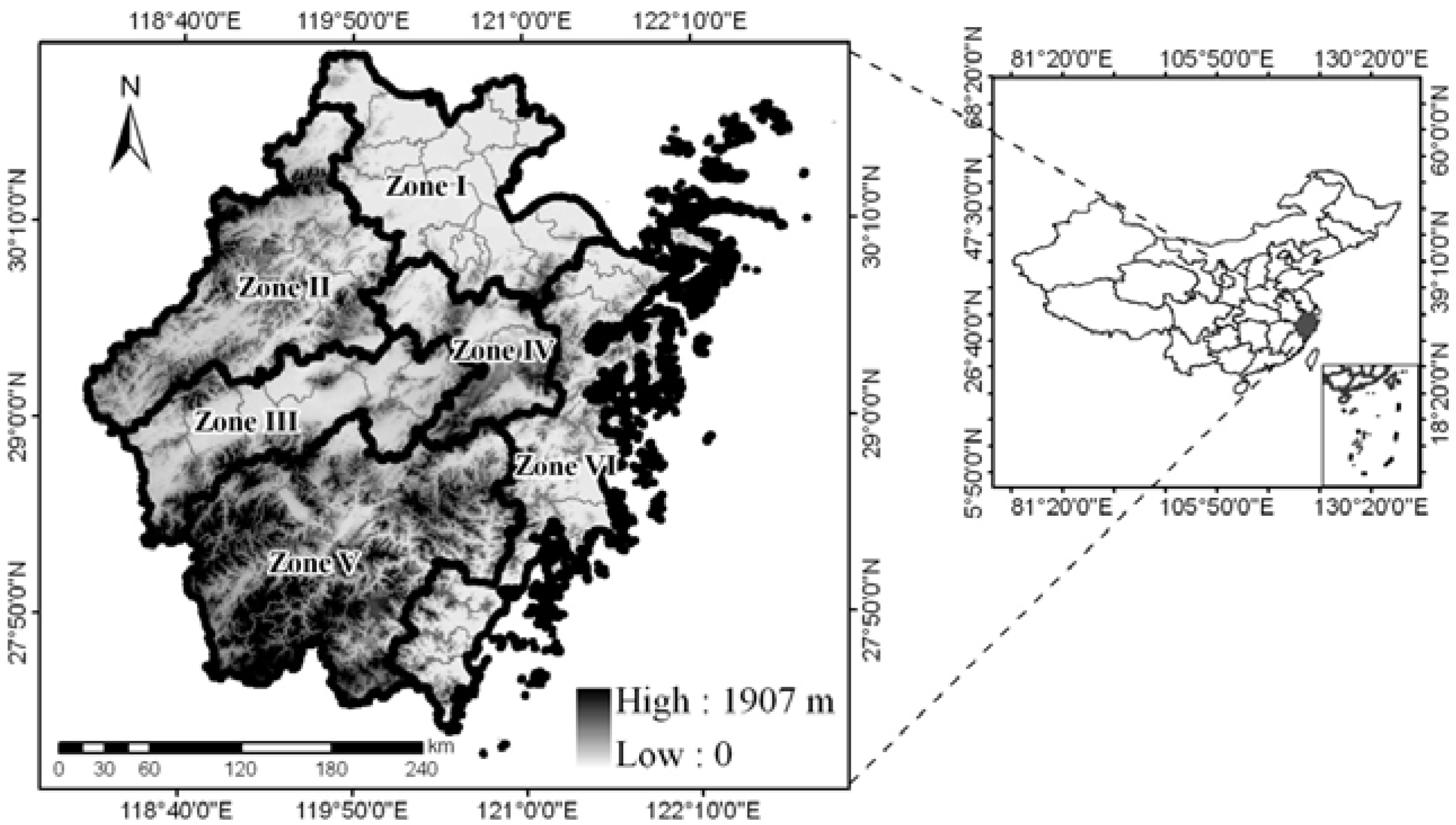
2.2. Partition of Geo-Zones in Zhejiang Province
| Geo-Zone | Area (km2) | Average Annual Temperature (°C) | Average Annual Rainfall (mm) | Population Density (Person/km) | GDP Per Capita (US Dollars) |
|---|---|---|---|---|---|
| Zone I | 16,774 | 17.8 | 1464.7 | 845.1 | 17,357.2 |
| Zone II | 20,269 | 17.5 | 1478.1 | 227.0 | 9133.8 |
| Zone III | 12,126 | 18.5 | 1265.9 | 424.2 | 9430.0 |
| Zone IV | 7936 | 17.8 | 1294.3 | 385.0 | 9534.1 |
| Zone V | 26,597 | 17.1 | 1250.5 | 196.0 | 5220.9 |
| Zone VI | 20,439 | 18.2 | 1526.2 | 786.7 | 12,580.1 |
2.3. Data Resources
3. Methodology
3.1. Summary Description of Soil Types
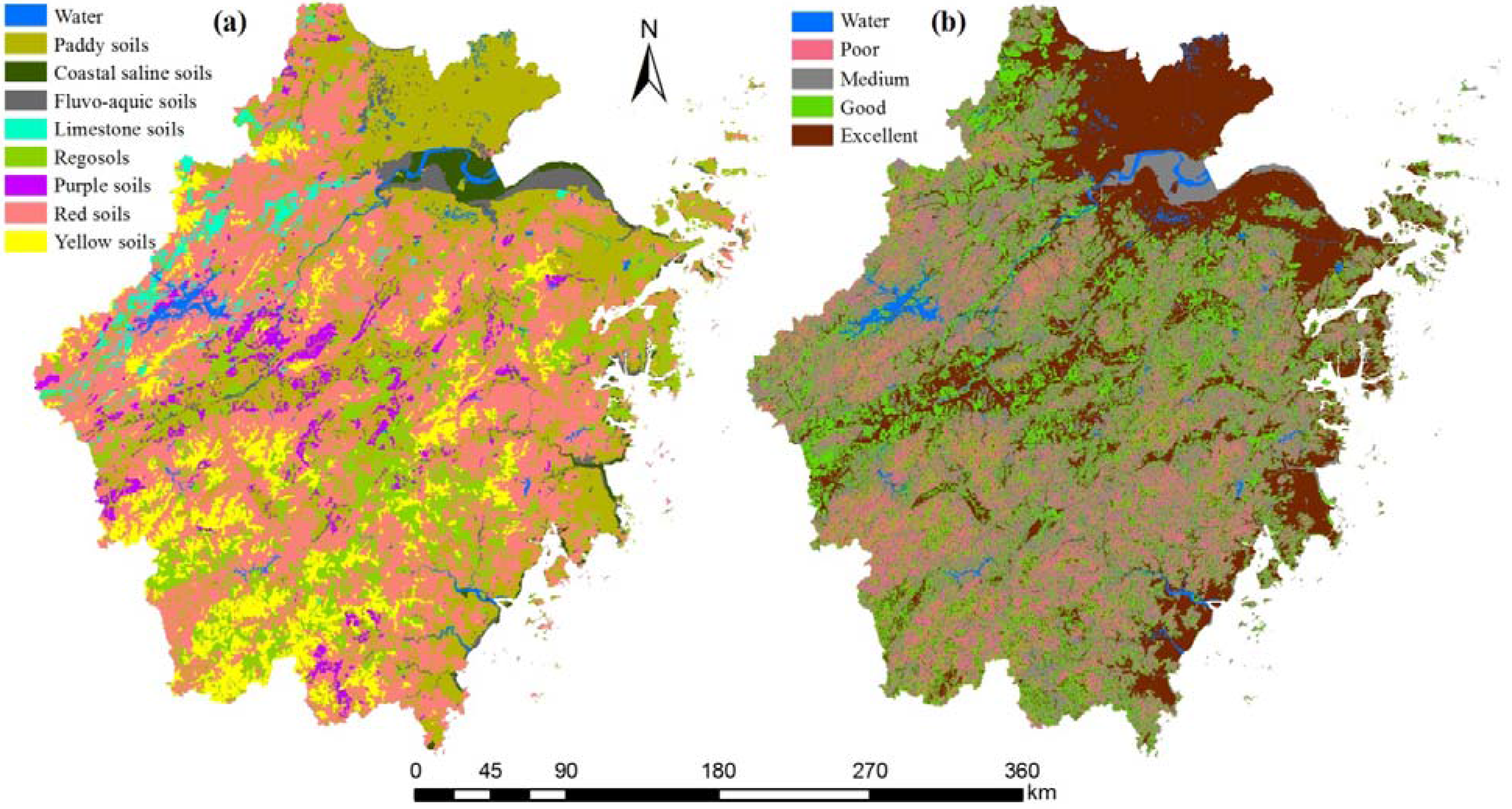
3.2. Soil Quality Assessment
| Indicator | Score | Weight | |||
|---|---|---|---|---|---|
| 1 | 2 | 3 | 4 | ||
| Depth (cm) | <50 | 50–75 | 75–100 | >100 | 0.1 |
| Texture | Heavy clay/sand | Light clay/sand clay | Clay loam/sand loam | Loam | 0.15 |
| SOM (g kg−1) | <1.4 | 1.4–2.5 | 2.5–3.4 | >3.4 | 0.15 |
| TN (g kg−1) | <0.08 | 0.08–0.12 | 0.12–0.18 | >0.18 | 0.1 |
| AP (mg kg−1) | <5 | 5–7 | 7–9 | >9 | 0.1 |
| AK (mg kg−1) | <61 | 61–84 | 84–106 | >106 | 0.1 |
| pH | >7.8 | ≤5.5 | 5.5–6.5;7.5–7.8 | 6.5–7.5 | 0.1 |
| Slope (degree) | 15–25 | 10–15 | 5–10 | <5 | 0.2 |
3.3. Metrics of Soil Landscape
| Metrics | Equations | Description |
|---|---|---|
| PD | where N represents the total number of soil patches; A is the total area of soil landscape | Represents the number of patches within an area of 1 km2 (numbers per 1 km2). PD > 0, higher value denotes higher fragmentation of soil landscape patterns. |
| LPI | where Xij represents the area of a patch | Represents the dominance of the largest soil patch (percent). 0 < LPI ≤ 100, higher value denotes higher dominance. |
| AWMSI | where pij and aij represents the parameter and area of patch j in soil type i | Represents the complexity and irregularity of soil patches. AWMSI ≥ 1, higher value denotes higher irregularity. |
| AI | where gij is the number of contacts between pixels of each soil type, Max→gij represents the maximum possible number of contacts between the pixels of soil type i | Reflects the aggregation level of soil types in a landscape (percent). 0 < AI ≤ 100, higher value denotes higher aggregation level. |
| SHDI | Pi is the percentage of the landscape occupied by soil type i | A measure of the diversity of different soil types in a landscape. SHDI ≥ 0, SHDI = 0 means there’s only one soil type comprising the landscape, higher value denotes higher soil diversity. |
4. Results and Discussion
4.1. Dynamics of Soil Sealing Process
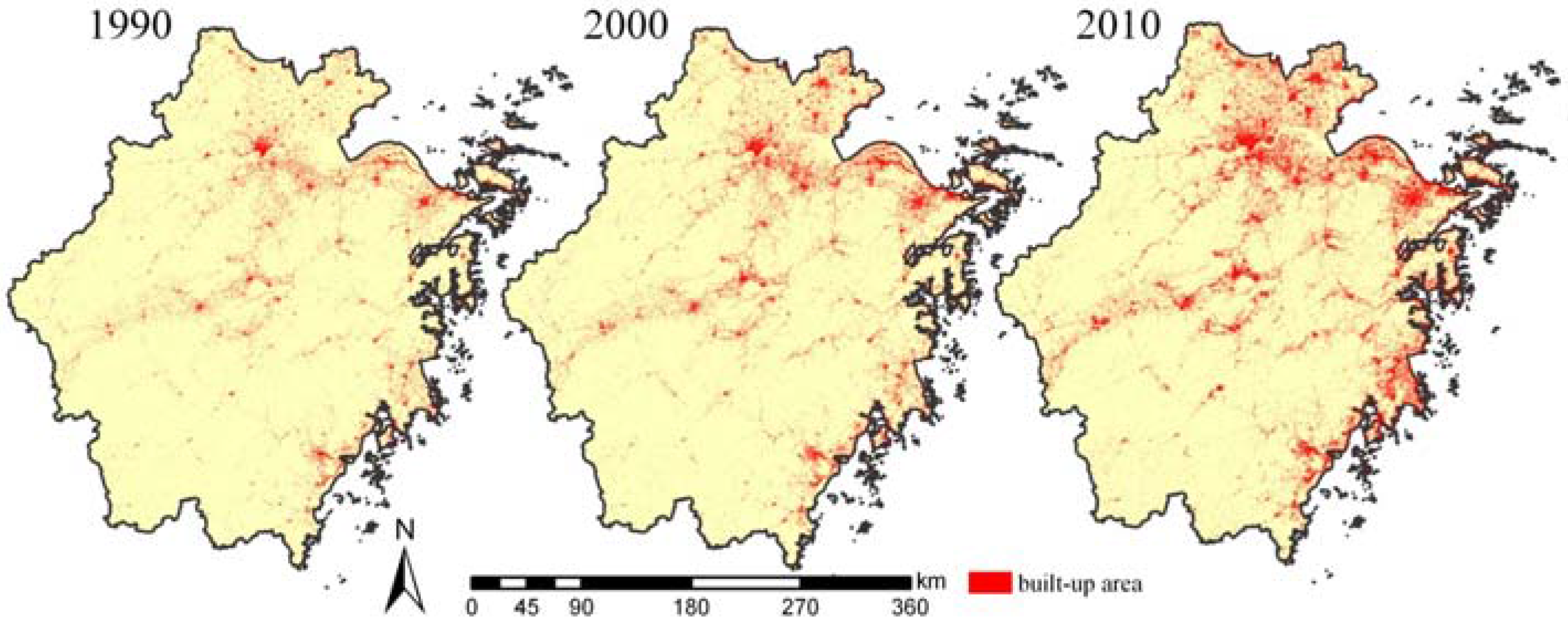
| Geo-Zone | 1990 | 2000 | 2010 | |
|---|---|---|---|---|
| Total area of sealed soil (km2) | Zhejiang Province | 4548.63 | 6785.55 | 10,968.48 |
| Average area of sealed soil for each city(km2) | Zone I | 102.30 | 167.51 | 262.94 |
| Zone II | 51.31 | 69.55 | 105.94 | |
| Zone III | 67.22 | 97.96 | 147.68 | |
| Zone IV | 55.29 | 77.91 | 137.45 | |
| Zone V | 23.79 | 32.45 | 55.03 | |
| Zone VI | 78.06 | 112.19 | 190.65 |
4.2. Type Composition of the Sealed Soils

4.3. Quality Estimation of the Sealed Soils
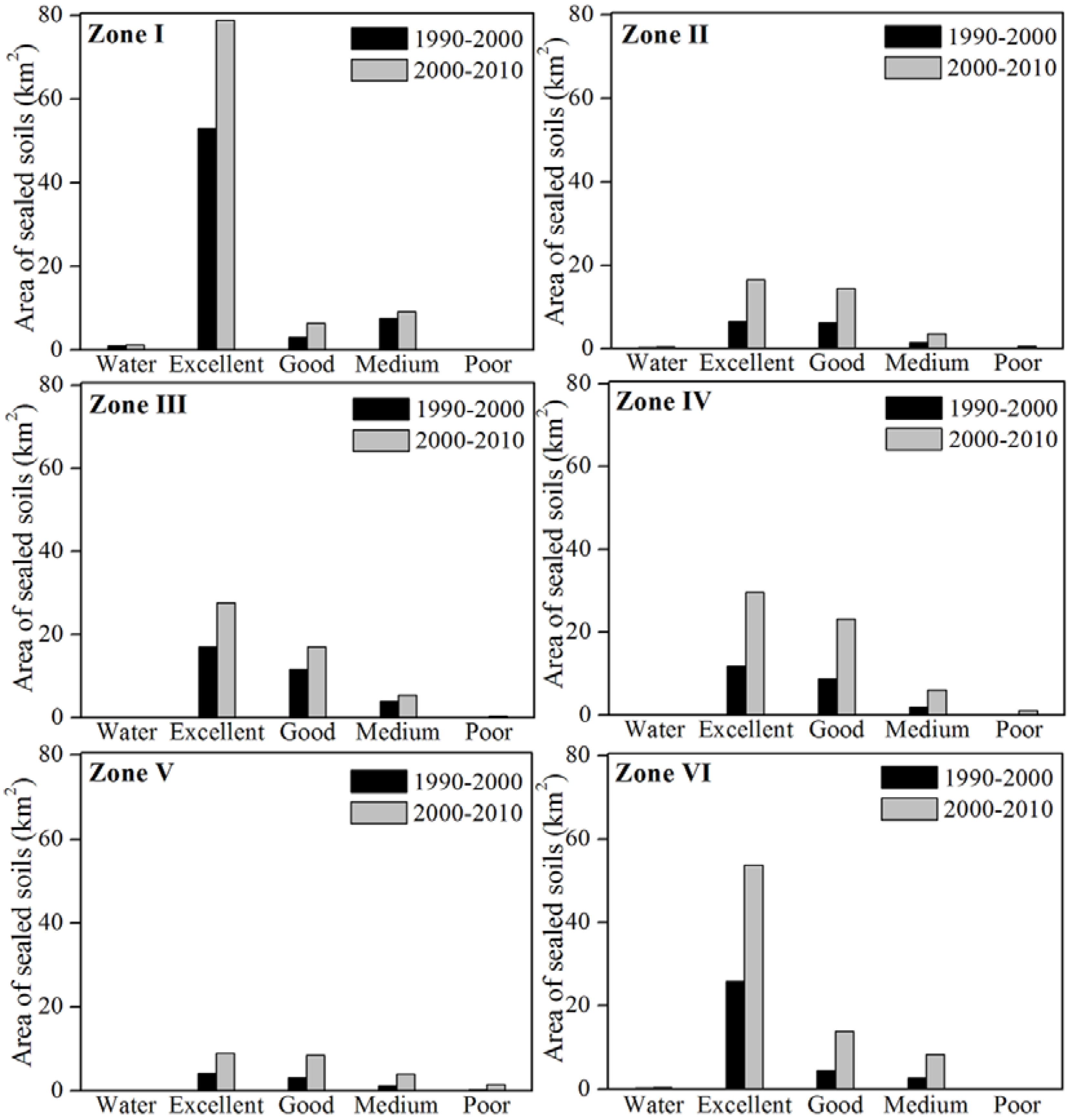
4.4. Soil Landscape Changes Due to Urbanization
| Metrics | 1990 | 2000 | 2010 | R (a) (1990–2000) | R (a) (2000–2010) |
|---|---|---|---|---|---|
| PD | 0.28 | 0.37 | 0.54 | 32.14% | 45.95% |
| LPI | 3.68 | 3.50 | 3.46 | −4.65% | −1.15% |
| AWMSI | 11.18 | 12.05 | 12.89 | 7.75% | 6.96% |
| AI | 9.77 | 9.74 | 9.68 | −0.36% | −0.52% |
| SHDI | 1.58 | 1.57 | 1.56 | −0.45% | −0.57% |
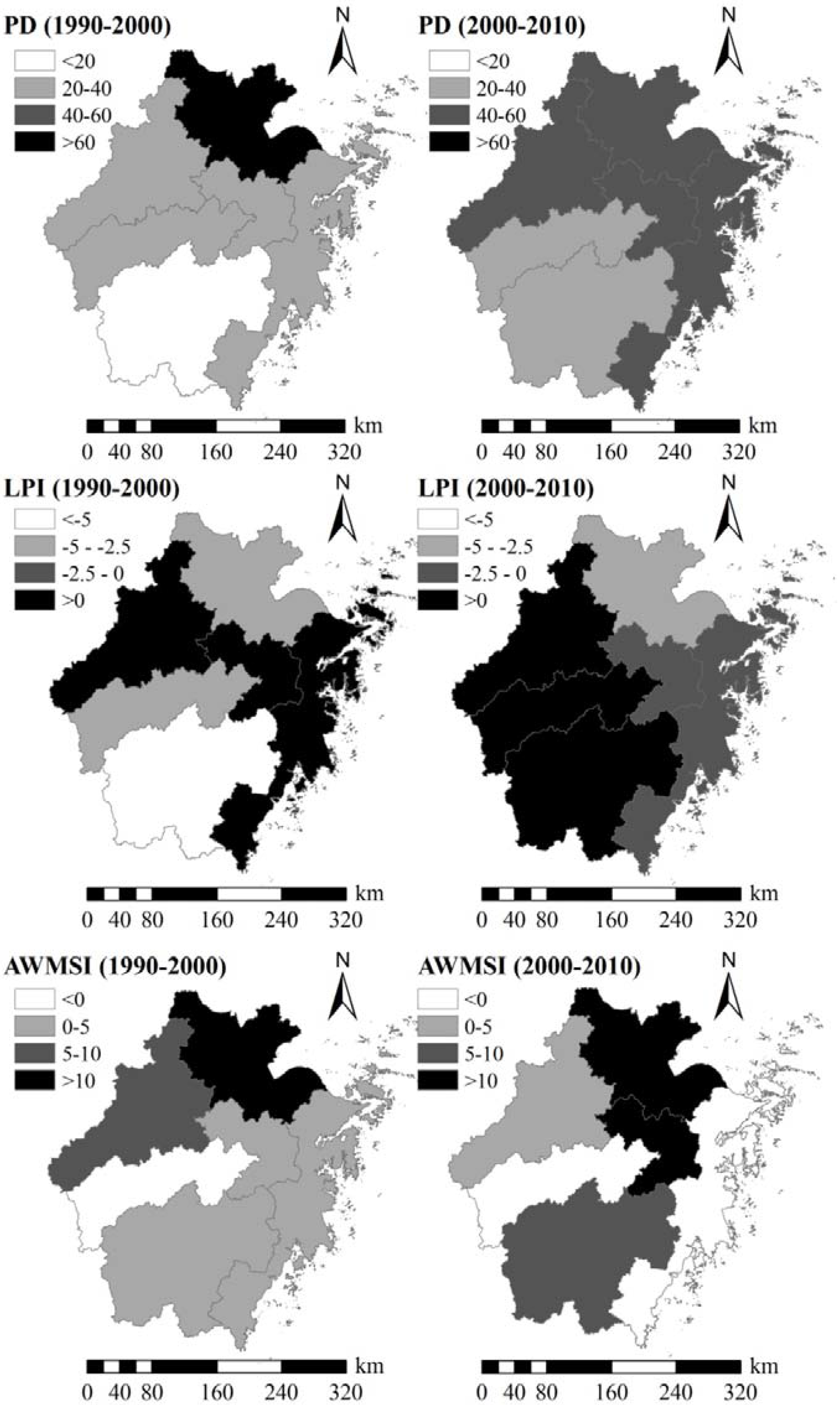
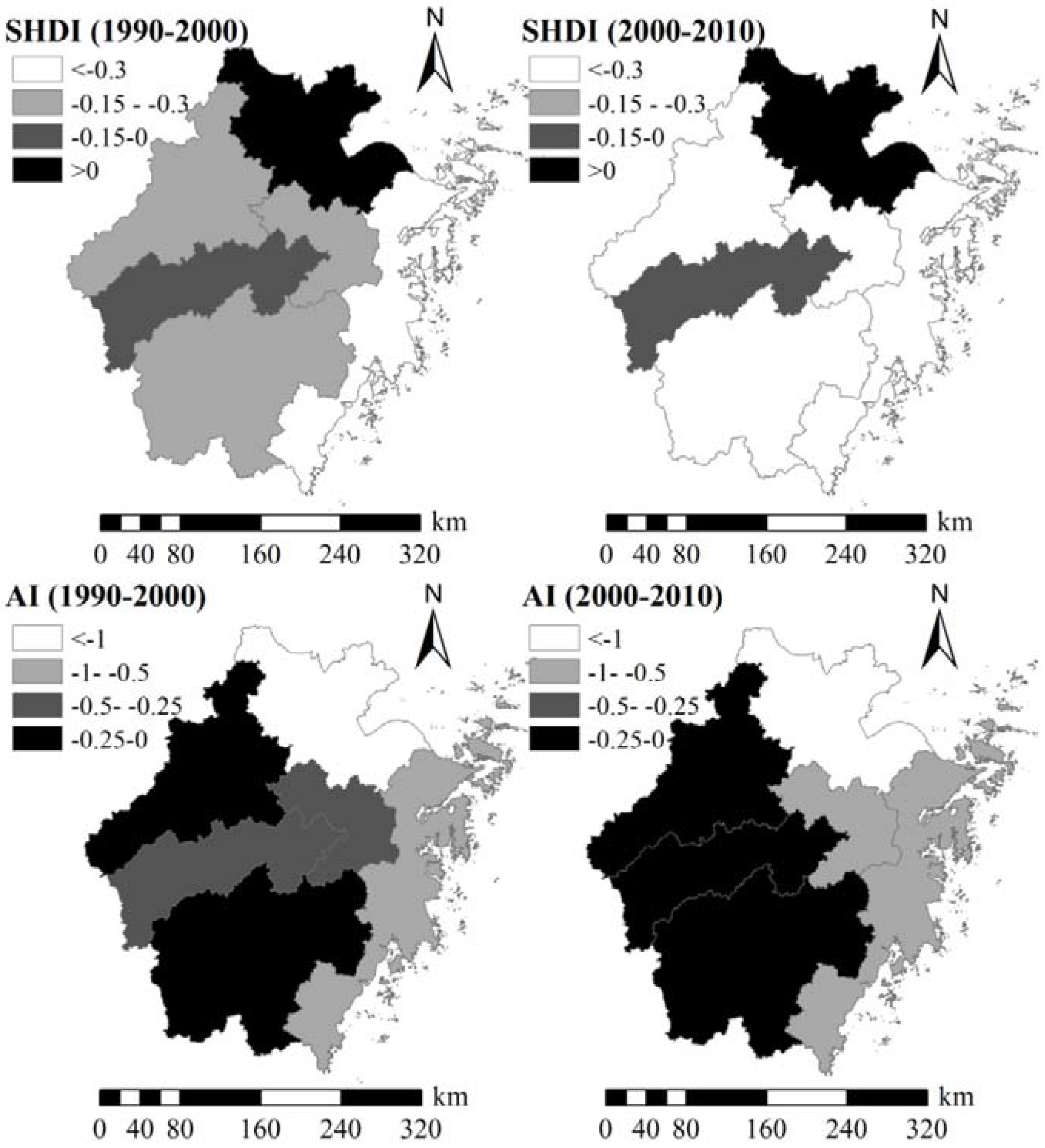
5. Conclusions
Acknowledgments
Author Contributions
Appendix
| Great Group of Zhejiang Soil Classification | Main Characteristics | World Reference Base Reference Soil Group (b) |
|---|---|---|
| Paddy soil | Modified from any soil material by long-continued cultivation, with an anthraquic horizon and plow sole | Anthrosols |
| Coastal saline soil | Weakly developed due to short pedogenic history; have a high concentration of soluble salts; alkaline soil. | Solonchaks |
| Fluvo-aquic soil | Influenced by rainfall, groundwater, and irrigation; the parent material is proluvium, river alluvium, etc. | Cambisols |
| Limestone soil | Weakly developed shallow soil with high pebble content; the parent material is limestone. | Cambisols |
| Regosols | Weakly developed mineral soils in unconsolidated materials, with shallow solum and strong acidity. | Regosols |
| Purple soil | Weakly developed shallow soil due to erosional influences. | Cambisols |
| Red soil | Developed under rapid weathering and strong leaching by erosion and deposition, presenting allitization and ferritization, with heavy texture and low ECEC. | Cambisols |
| Yellow soil | Similar to red soil, distributed on higher altitude compared with red soil, characterized by an additional litter layer above humus horizon. | Cambisols |
Conflicts of Interest
References
- Scalenghe, R.; Malucelli, F.; Ungaro, F.; Perazzone, L.; Filippi, N.; Edwards, A.C. Influence of 150 years of land use on anthropogenic and natural carbon stocks in Emilia-Romagna region (Italy). Environ. Sci. Tech. 2011, 45, 5112–5117. [Google Scholar] [CrossRef] [PubMed]
- Depietri, Y.; Renaud, F.G.; Kallis, G. Heat waves and floods in urban areas: A policy-oriented review of ecosystem services. Sustain. Sci. 2012, 7, 95–107. [Google Scholar] [CrossRef]
- Zhang, B.; Zhang, Y.; Chen, D.; White, R.E.; Li, Y. A quantitative evaluation system of soil productivity for intensive agriculture in China. Geoderma 2004, 123, 319–331. [Google Scholar] [CrossRef]
- Barbero-Sierra, C.; Marques, M.J.; Ruíz-Pérez, M. The case of urban sprawl in Spain as an active and irreversible driving force for desertification. J. Arid. Environ. 2013, 90, 95–102. [Google Scholar] [CrossRef]
- Pouyat, R.; Yesilonis, I.; Russell-Anelli, J.; Neerchal, N. Soil chemical and physical properties that differentiate urban land-use and cover types. Soil Sci. Soc. Am. J. 2007, 71, 1010–1019. [Google Scholar] [CrossRef]
- D’Angelo, M.; Enne, G.; Madrau, S.; Zucca, C. Soil consumption by urbanisation: A case study in northern Sardinia (Italy). Opt. Méditerr. Sér. A Sémin. Méditerr. 2001, 44, 287–293. [Google Scholar]
- Morello, J.; Buzai, G.D.; Baxendale, C.A.; Rodríguez, A.F.; Matteucci, S.D.; Godagnone, R.E.; Casas, R.R. Urbanization and the consumption of fertile land and other ecological changes: The case of Buenos Aires. Environ. Urban. 2000, 12, 119–131. [Google Scholar] [CrossRef]
- Gardi, C.; Panagos, P.; Liedekerke, M.V.; Bosco, C.; Brogniez, D.D. Land take and food security: Assessment of land take on the agricultural production in Europe. J. Environ. Plan. Manag. 2015, 58, 898–912. [Google Scholar] [CrossRef]
- Munafò, M.; Salvati, L.; Zitti, M. Estimating soil sealing rate at national level-Italy as a case study. Ecol. Indic. 2013, 26, 137–140. [Google Scholar] [CrossRef]
- Xiao, R.; Su, S.; Zhang, Z.; Qi, J.; Jiang, D.; Wu, J. Dynamics of soil sealing and soil landscape patterns under rapid urbanization. CATENA 2013, 109, 1–12. [Google Scholar] [CrossRef]
- Deng, X.; Zhan, J.; Chen, R. The patterns and driving forces of urban sprawl in China. In Proceedings of the 2005 IEEE International Geoscience and Remote Sensing Symposium, Seoul, Korea, 25–29 July 2005; pp. 1511–1513.
- Liu, J.; Zhang, Z.; Xu, X.; Kuang, W.; Zhou, W.; Zhang, S.; Li, R.; Yan, C.; Yu, D.; Wu, S. Spatial patterns and driving forces of land use change in China during the early 21st century. J. Geogr. Sci. 2010, 20, 483–494. [Google Scholar] [CrossRef]
- Chen, J. Rapid urbanization in China: A real challenge to soil protection and food security. CATENA 2007, 69, 1–15. [Google Scholar] [CrossRef]
- Uuemaa, E.; Roosaare, J.; Kanal, A.; Mander, Ü. Spatial correlograms of soil cover as an indicator of landscape heterogeneity. Ecol. Indic. 2008, 8, 783–794. [Google Scholar] [CrossRef]
- Shan, Z. Wang Shixing in Zhejiang Province. Chin. Natl. Geogr. 2012, 1, 1–29. [Google Scholar]
- Zhejiang Provincial Bureau of Statistics. Zhejiang Statistical Yearbook; China Statistics Press: Beijing, China, 1991–2014. [Google Scholar]
- Soil Survey Office of Zhejiang Province. Zhejiang Soil; Zhejiang Science & Technology Press: Hangzhou, China, 1994. [Google Scholar]
- Ditzler, C.A.; Tugel, A.J. Soil quality field tools. Agron. J. 2002, 94, 33–38. [Google Scholar] [CrossRef]
- Li, C.; He, Y.; Wang, Y.; Liu, X. Effect of N, P and K fertilizer application on rice grain yield in red paddy soil. Chin. J. Rice Sci. 2007, 21, 179–184. [Google Scholar]
- Li, P.; Zhang, T.; Wang, X.; Yu, D. Development of biological soil quality indicator system for subtropical China. Soil Till. Res. 2013, 126, 112–118. [Google Scholar] [CrossRef]
- Liao, K.; Xu, S.; Wu, J.; Ji, S.; Lin, Q. Cokriging of soil cation exchange capacity using the first principal component derived from soil physico-chemical properties. Agr. Sci. China 2011, 10, 1246–1253. [Google Scholar] [CrossRef]
- Pan, G.; Smith, P.; Pan, W. The role of soil organic matter in maintaining the productivity and yield stability of cereals in China. Agr. Ecosyst. Environ. 2009, 129, 344–348. [Google Scholar] [CrossRef]
- Qi, Y.; Darilek, J.L.; Huang, B.; Zhao, Y.; Sun, W.; Gu, Z. Evaluating soil quality indices in an agricultural region of Jiangsu Province, China. Geoderma 2009, 149, 325–334. [Google Scholar] [CrossRef]
- Ma, W.; Zhang, M.; Lv, X. Analysis of N, P and K in arable lands of Zhejiang Province. J. Zhejiang Univ. (Agric. Life Sci.) 2012, 38, 71–80. [Google Scholar]
- Deng, J.; Qiu, L.; Wang, K.; Yang, H.; Shi, Y. An integrated analysis of urbanization-triggered cropland loss trajectory and implications for sustainable land management. Cities 2011, 28, 127–137. [Google Scholar] [CrossRef]
- Zhang, X.; Zhu, X.; Wang, K.; Sheng, Z.; Xu, H.; Ding, X.; Luo, P.; Yu, Z. Evaluation of potential for exploiting arable land in low hilly red soil region in Lanxi based on remote sensing and GIS. Trans. CSAE 2008, 24, 114–118. [Google Scholar]
- Deng, J.; Wang, K.; Hong, Y.; Qi, J. Spatio-temporal dynamics and evolution of land use change and landscape pattern in response to rapid urbanization. Landsc. Urban Plan. 2009, 92, 187–198. [Google Scholar] [CrossRef]
- Li, J.; Deng, J.; Wang, K.; Li, J.; Huang, T.; Lin, Y.; Yu, H. Spatiotemporal patterns of urbanization in a developed region of eastern coastal China. Sustainability 2014, 6, 4042–4058. [Google Scholar] [CrossRef]
- Su, S.; Xiao, R.; Jiang, Z.; Zhang, Y. Characterizing landscape pattern and ecosystem service value changes for urbanization impacts at an eco-regional scale. Appl. Geogr. 2012, 34, 295–305. [Google Scholar] [CrossRef]
- Pandey, A.C.; Kumar, A.; Jeyaseelan, A. Urban built-up area assessment of Ranchi township using cartosat-i stereopairs satellite images. J. Indian Soc. Remote. Sens. 2013, 41, 141–155. [Google Scholar] [CrossRef]
- Wei, Y.D.; Ye, X. Regional inequality in China: A case study of Zhejiang Province. Tijdschr. Econ. Soc. Geogr. 2004, 95, 44–60. [Google Scholar] [CrossRef]
- Li, Z.; Zhang, T.; Chen, B. Changes in organic carbon and nutrient contents of highly productive paddy soils in Yujiang County of Jiangxi Province, China and their environmental application. Agri. Sci. China 2006, 5, 522–529. [Google Scholar] [CrossRef]
- Pan, X.; Zhao, Q. Measurement of urbanization process and the paddy soil loss in Yixing city, China between 1949 and 2000. CATENA 2007, 69, 65–73. [Google Scholar] [CrossRef]
- Su, S.; Zhang, Q.; Zhang, Z.; Zhi, J.; Wu, J. Rural settlement expansion and paddy soil loss across an ex-urbanizing watershed in eastern coastal China during market transition. Reg. Environ. Chang. 2011, 11, 651–662. [Google Scholar] [CrossRef]
- Zhang, W.W.; Wang, W.; Li, X.W.; Ye, F.Z. Economic development and farmland protection: An assessment of rewarded land conversion quotas trading in Zhejiang, China. Land Use Policy 2014, 38, 467–476. [Google Scholar] [CrossRef]
- Weng, Y. Spatiotemporal changes of landscape pattern in response to urbanization. Landsc. Urban Plan. 2007, 81, 341–353. [Google Scholar] [CrossRef]
- Shi, Z.; Wang, R.; Huang, M.X.; Landgraf, D. Detection of coastal saline land uses with multi-temporal Landsat images in Shangyu city, China. Environ. Manag. 2002, 30, 142–150. [Google Scholar] [CrossRef] [PubMed]
- Zhang, H.; Li, J.; Niu, D. Study on spatial optimization allocation of land use in the typical red soil hilly region in south China. Acta. Geogr. Sin. 2003, 58, 668–676. [Google Scholar]
- Imhoff, M.L.; Lawrence, W.T.; Elvidge, C.D.; Paul, T.; Levine, E.; Privalsky, M.V.; Brown, V. Using nighttime DMSP/OLS images of city lights to estimate the impact of urban land use on soil resources in the United States. Remote. Sens. Environ. 1997, 59, 105–117. [Google Scholar] [CrossRef]
- Skinner, M.W.; Kuhn, R.G.; Joseph, A.E. Agricultural land protection in China: A case study of local governance in Zhejiang Province. Land Use Policy 2001, 18, 329–340. [Google Scholar] [CrossRef]
- Zhong, T.; Mitchell, B.; Huang, X. Success or failure: Evaluating the implementation of China’s national general land use plan (1997–2010). Habitat. Int. 2014, 44, 93–101. [Google Scholar] [CrossRef]
- Franczyk, J.; Chang, H. The effects of climate change and urbanization on the runoff of the Rock Creek basin in the Portland metropolitan area, Oregon, USA. Hydrol. Process. 2009, 23, 805–815. [Google Scholar] [CrossRef]
- Yeh, C.T.; Huang, S. Investigating spatiotemporal patterns of landscape diversity in response to urbanization. Landsc. Urban Plan. 2009, 93, 151–162. [Google Scholar] [CrossRef]
- Crist, M.R.; Wilmer, B.; Aplet, G.H. Assessing the value of roadless areas in a conservation reserve strategy: Biodiversity and landscape connectivity in the northern Rockies. J. Appl. Ecol. 2005, 42, 181–191. [Google Scholar] [CrossRef]
- Wu, J.; Jenerette, G.D.; Buyantuyev, A.; Redman, C.L. Quantifying spatiotemporal patterns of urbanization: The case of the two fastest growing metropolitan regions in the United States. Ecol. Complex. 2011, 8, 1–8. [Google Scholar] [CrossRef]
- IUSS Working Group WRB. World Reference Base for Soil Resources 2014; World Soil Resources Reports No.106; FAO: Rome, Italy, 2014. [Google Scholar]
- Zhi, J.; Jing, C.; Lin, S.; Zhang, C.; Wu, J. Estimates of soil organic carbon stocks in Zhejiang Province of China based on 1:50 000 soil database using the PKB method. Pedosphere 2015, 25, 12–24. [Google Scholar] [CrossRef]
© 2015 by the authors; licensee MDPI, Basel, Switzerland. This article is an open access article distributed under the terms and conditions of the Creative Commons Attribution license (http://creativecommons.org/licenses/by/4.0/).
Share and Cite
Li, J.; Deng, J.; Gu, Q.; Wang, K.; Ye, F.; Xu, Z.; Jin, S. The Accelerated Urbanization Process: A Threat to Soil Resources in Eastern China. Sustainability 2015, 7, 7137-7155. https://doi.org/10.3390/su7067137
Li J, Deng J, Gu Q, Wang K, Ye F, Xu Z, Jin S. The Accelerated Urbanization Process: A Threat to Soil Resources in Eastern China. Sustainability. 2015; 7(6):7137-7155. https://doi.org/10.3390/su7067137
Chicago/Turabian StyleLi, Jiadan, Jinsong Deng, Qing Gu, Ke Wang, Fangjin Ye, Zhihao Xu, and Shuquan Jin. 2015. "The Accelerated Urbanization Process: A Threat to Soil Resources in Eastern China" Sustainability 7, no. 6: 7137-7155. https://doi.org/10.3390/su7067137





